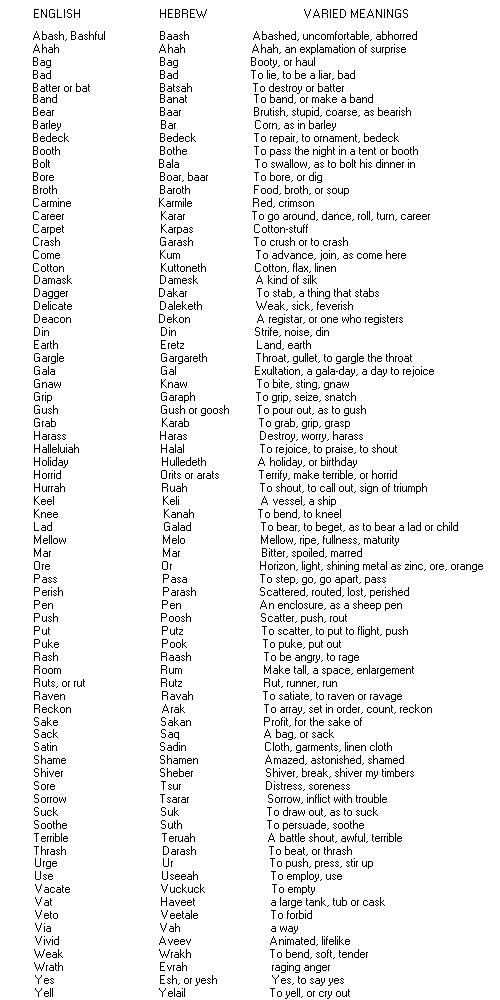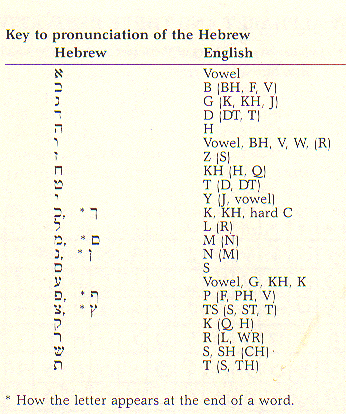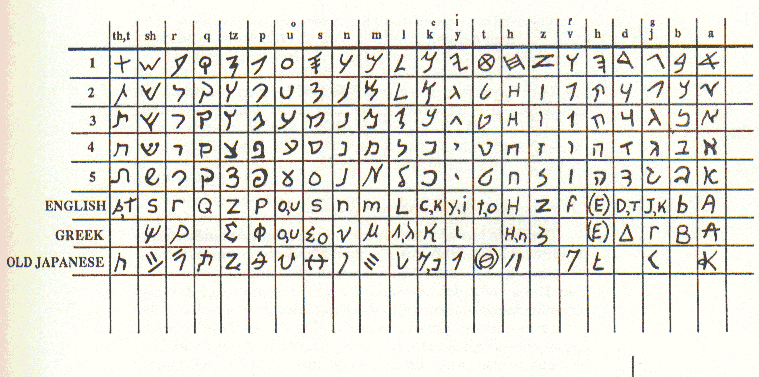"And the whole earth was of one language,
and of one speech" Genesis 11:1 (KJV)
Very few in this modern world now take the above Scripture passage seriously! Let us
take a look at the evidence that support it.
"over 75 percent of English words come direct from Hebrew words"
The above quote was published in 1985 and was based mainly on the work of
a Professor Edward Odlum in his work "God's Covenant Man" (1916).
Wait a minute, I have heard people speak in Hebrew, and it sure don't sound
like English!! You have got to be kidding!!
But let us take a closer look at the facts remembering that dialects within
the same language can make it difficult for communication between even those
who supposedly speak the same language. Just a few of the English dialects of
today include New Yorker English, Southern drawl, Texan, Midwestern, and let us
not forget the English from the "parent" country, Great Britain. No matter
which dialect you speak you may have to ask someone with a different dialect
to repeat a sentence or phrase before you can understand it! Then how difficult
would it be for the same language a few hundred years ago, or a few thousand
years ago? I imagine most of us have seen old writings such as those of the
founders of our country and noticed that some of the letters look "funny" and
some of the words were spelled different. And most of us are familiar with
the truism that most of the languages of modern Europe come from one "parent"
language. Cannot we then carry this back even further to the possibly most
all languages came from one "parent" language?
Over time languages under go a transformation and spellings change, and
meanings change, but still many of the basics stay mostly the same. There
are certain transformations that take place that most of us are familiar with.
For instance when changing a word to the plural or adding ng to the end of a word
we often have to make a letter change or add a letter. This is the type of
changes that have happened over time as the various languages evolved. Mostly
the vowels are to a large part interchangeable when comparing words from
different languages and are to be mostly ignored. The original Biblical Hebrew
in effect had no vowels, only the constants were of importance.
Also all letters that are pronounced with the same part of the mouth can
be considered as interchangeable. M and N are interchangeable nasal sounds and
D, T, and TH can be considered as the "same" letter. This is known as Grimm's
law, given to us by the same Jakob Grimm who gave us the fairy tales.
It is also common to reverse letters and even in some cases to reverse
the entire word.
Also letters can be dropped or added.
Let us look at the English word "direct". Ignoring the vowels, we have
basically a three letter word d-r-ct. By the rules of constant sounds made
by the same part of the mouth the following are considered as the same,
D-T-DT-TH, R-L-WR, and H-K-Q-KH-G & hard C. Now examine the following figure
and notice how various languages have a word that has to do with direct, direction,
road, path, pathway, way, track, journey, all related meanings. In nearly all cases
the center sound has stayed the same and mostly the first sound has been retained, but
dropped by some, and in some cases the last sound has been dropped.
 Fig1
Fig1
Let us also look at a very small sampling of words that have the same sound
and meaning in both English and Hebrew in the figure to follow.
 Fig2
Fig2
A student of the Anglo-Saxon language provided some very interesting old Saxon
words for a further illustration. These words are believed to be old enough that
they would not be corrupted by more modern influences. The table below may seem
rather confusing, but remember ancient Hebrew had only 22 letters, all of which were
consider as consonants (see Appendix A), therefore we would have a match when we have matched the
meaning and the consonants only of the old Saxon word, and considering the
interchangeability of the consonants as provided in parenthesis where appropriate.
Do we get 100 percent matches? No obviously not , but remember we are examining words whose
origins go back many thousands of years, and thus have had considerable opportunity for changes and
corruptions.
 Fig3
Fig3
(ref: "A Concise Dictionary of the words in The Hebrew Bible ...", by James Strong)
In his book "The Word" Isaac Mozeson, published by Shapolsky Publishers, Inc.
(1989), has documented the connection between English and Hebrew for many
thousands of words.
Conclusion: we have documented in a small way the interconnection between
English and other languages to the proposed "patriarch" of languages, Hebrew.
The references do a much better and thorough job.
It obviously would be much more difficult to show that the Hebrew language
was the true language of the time before Babel, but hopefully in the near future
there will be found some way to show this relationship as the archeologists
make more discoveries. (see Appendix A)
References:
1) "God's Covenant" by Professor Edward Odlum (1916) as referenced in
"Missing Links Discovered in Assyrian Tablets" by E. Raymond Capt, Artisan Sales
(1985)
2) "The Word" by Isaac E. Mozeson, Shapolsky Publishers, Inc. (1989)
(You may want to visit his web site at http://www.homestead.com/edenics )
Appendix A: Keys to Hebrew
(ref: "The Word" by Isaac E. Mozeson, Shapolsky Publishers, Inc. (1989))

The Alphabet and Derivatives
KEY
1. Hebrew-Phoenecian: about 8th century B.C.
2. Hebrew-Aramaic: 6th-4th century B.C.
3. Dead-Sea scrolls: about 1st century B.C.
4. Modern Print Letters
5. Modern cursive letters
Appendix B: Evidences from Mesopotamia
"In those days, the lands of Subur (and) Hamazi,
Harmony-tongued (?) Sumer, the great land of the decrees of princeship,
Uri, the land having all that is appropriate(?),
The land Martu, resting in security,
The whole universe, the people in unison (?)
To Enlil in one tongue [spoke]. ...
(Then) Enki, the lord of abundance,
(whose) commands are trustworthy,
The lord of wisdom, who understands the land,
The leader of the gods,
Endowed with wisdom, the lord of Eridu
Changed the speech in their mouths,
[brought (?)] contention into it,
Into the speech of man that (until then) had been one.
(translation from "The Babel of Tongues: A Sumerian Version" by Kramer, S.N.,
Journal of the American Oriental Society 88:108-11,1968)
In Babylonia the archaeologists have discovered remains of many towers, called Ziggurats
(Akkadian word ziqqurat from zaqaru, to be high).
They are of varing sizes from 20 meters on a side to over 90 meters on a side.
More than 30 have been discovered and they had names like "Temple of
the Foundation of Heaven and Earth", "Temple that Links Heaven and
Earth", "Temple of the Exalted Mountain", "Temple of Exalted Splendor",
and "Temple of the Stairway to Pure Heaven".
It is believed that the earliest was located at Eridu, which
according to Sumerian tradition was the first city. Some are
multi-layered, up to 16 layers, with each being built over the remains
of earlier structures. The building materials were sun dried bricks in
the centers and burnt bricks and bitumen mortar for the outer layers.
(Ref. "The Mesopotamian Background of the Tower of Babel Account and its
Implications, by John H. Walton, Bible and Spade Vol. 9, No. 3, Summer 1996)
And while the above described structures are the most famous and many have proposed
that one of them is the Tower of Babel, in fact none of them are the oldest
that have been found to date. Reportedly the oldest found to date is Teppe Sialk which is
located south of Tehran, Iran. The main ziggurat has been dated to 2900 BC. And
a near by second mound has been dated by a joint study between Iran's Cultural
Heritage Organization, The Louvre, and Institute Francais de Recherche en Iran
to indicate that the oldest settlements in Sialk date back to 5500 BC. (Ref.
http://www.crystalinks.com/pyramidiraq.html)
 The Ziggurat at Sialk
The Ziggurat at Sialk
Were any of these the true Tower of Babel ? Answer: NO !
There have long been traditions that the true "Ur of the Chaldees" was located in
the north at Urfa, twenty miles northwest of Haran. And supported by many
distinguished scholars such as Cyrus H. Gordon in "The World of the Old Testament",
New York: Doubleday and Co., 1948, p. 132. Also some of the latest archaeological
and language studies support the dividing of the languages as occurring in
Anatolia Turkey.
"A family tree of Indo-European languages suggests they began to
spread and split about 9,000 years ago. The finding hints that
farmers in what is now Turkey drove the language boom - and not
later Siberian horsemen, as some linguists reckon. ... Around this time,
farming techniques began to spread out of
Anatolia - now Turkey - across Europe and Asia, archaeological evidence shows."
(From "Language tree rooted in Turkey" by John Whitfield, http://www.nature.com/
nsu/nsu_pf/ 031124/ 031124-6.html) (more)
Therefore,
this evidence indicates that all of the early history of Genesis 1-11 was located
in the Ararat area and the northern most portion of Mesopotamia and there would
have been located the true tower of Babel.
The Scriptural Hebrew account
is so brief that it is difficult to discern the full story. Many have implied
that immediately the workers on the tower were unable to understand each other
and quit work in confusion. When in fact, there is no mention of the time factor
and the method of "confounding" the languages is also not discussed. The basic
meaning of the Hebrew word "balal" (Strong's #1101) is to overflow and then by implication,
to mix.
From Flavius Josephus, "The Antiquities of the Jews", we get a quote from "The Sibyl";
"When all men were of one language, some of them built a high tower,
as if they would thereby ascend up to heaven,
but the gods sent storms of wind and overthrew the tower,
and gave every one his peculiar language;
and for this reason it was that the city was called Babylon."
Possibly then the manner in which the Lord initiated the confusion, "let us go down",
was via a natural catastrophe. If this was the major contributing factor or just
a part of the whole of the "confounding" is difficult to understand.
The above non-scriptural account would seem to indicate a two part event, with
first a blowing over of the tower and then a giving of a "peculiar language"
to each person.
Today many that supposedly
speak the same language have radically different understandings of the same words.
We could on a lighter side theorize that possibly some were enrolled in east side
schools (liberal) and the others were educated in west side schools (conservative).
We also know that men readily make changes in their languages and often in
very short time spans as slangs crop up and then these slangs are more permanently
incorporated into the language. Therefore, many like
to propose the concept that languages are continuously "evolving" and than over time humans
evolved their languages from much simpler languages, grunts and gestures. However some recent studies
have indicated that there are no simple "evolving" languages on the
present earth and some languages are actually with time being simplified.
"All contemporary modern humans use very complex languages.
There are no "primitive" languages: the 5,000 or more spoken today are equally
flexible and expressive, and their grammar and syntax are sometimes richer and
more precise than that of the more widespread like English and Spanish,
which have undergone some simplification over the centuries." (ref: Luigi Lura Cavalli-Sforza,
"Genes, People and Languages", New York:North Pointe Press, 2000, page 59)
Therefore as has been proposed by some students, our present languages
are not necessarily evolving, but actually doing the opposite and becoming more
simplified and less exacting. We may actually have many more words to speak and write with, but
we may in fact have languages today that are less capable.
Indications such as these have caused some linguists to conclude that the nature of
the language situation is almost
"insoluble". The Dead Sea Scrolls, however, are evidence that for millenniums the believers were
very exacting in maintaining the "sacred" records! We can probably assume that
the non-believers were not necessarily so exacting. Could it be that the ones
in Babel having strayed from the faith no longer felt it imperative to hold
to the "sacredness" of the original language and teachings given of the Lord,
and this was a part of the causation of the "confounding"? Or how about the possibililty
that the only scholars/scribes of the area and their records were destroyed when the tower
collapsed?
Possibly we should better consider that the process
was not short term, but a long term process occurring over centuries. With
first a dividing of the people along ideological/religious lines. Then with each subgroup/clan
developing their own rituals and jargon which with time developed into distinct dialects
encouraged by the desire for each group to separate from the others. Possibly this process
had already started as each subgroup strayed from the original beliefs and was then
accelerated when the tower was destroyed. Providing an initiative for each to go off and build
a new center of worship which more aligned with their rituals. And of course it is
not unreasonable to assume that many fights and wars erupted as part of this process.
This long term process could more readily align with the perspective that we have proposed
on the chronologies.
So in summary, we just don't fully understand the nature of
the events that caused the "confounding" and the scattering, and over what time
period it all took place, the Scriptural record is just too brief! It would seem
most likely that it was a long term process and that it occurred in Anatolia !
 Fig1
Fig1 Fig2
Fig2 Fig3
Fig3



